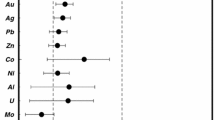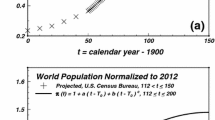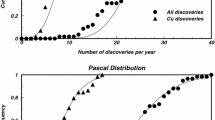Abstract
Supplying worldwide demand of metallic raw materials throughout the rest of this century may require 5–10 times the amount of metals contained in known ore deposits. This demand can be met only if mineral deposits containing the required masses of metals, in excess of present day ore reserves, exist in the Earth’s crust. It is, by definition, not known whether or not such mineral deposits exist. On the basis of the statistical distribution of metal tonnages contained in known ore deposits, however, it is possible to place constraints on the size distribution of the deposits that must be discovered in order to meet the expected demand. A nondimensional analysis of the distribution of metal tonnages in deposits of 20 metals shows that most of them follow distributions that, although not strictly lognormal, share important characteristics with a lognormal distribution. Chief among these is the observation that frequency falls off symmetrically and geometrically with deposit size, relative to a median deposit size that is approximately equal to the geometric mean deposit size. An immediate consequence of this behavior is that most of the metal endowment is concentrated in deposits that are several orders of magnitude larger than the median deposit size, and that are much rarer than the most common deposits that cluster around the median deposit size. The analysis reveals remarkable similarities among the statistical distributions of most of the metals included in this study, in particular, the fact that distribution of most metals can be fully described with essentially the same value (about 2–3) of the scale parameter, σ, which is the only parameter needed to describe the behavior of a normalized lognormal variable. This observation makes it possible to derive the following general conclusions, which are applicable to most metals—both scarce and abundant. First, it is unlikely that undiscovered mineral deposits of sizes comparable to those that contain most of the known metal endowment exist in sufficient quantities to supply the expected worldwide demand throughout the rest of this century. Second, if the expected demand is to be met, one must hope that very large deposits, perhaps up to one order of magnitude larger than the largest known deposits, exist in accessible portions of the Earth’s crust, and that these deposits are discovered.














Similar content being viewed by others
References
Agterberg, F. P. (1995). Multifractal modeling of the size and grade of giant and supergiant deposits. International Geology Review, 37, 1–8.
Agterberg, F. P. (2007). Mixtures of multiplicative cascade models in geochemistry. Nonlinear Processes in Geophysics, 14, 201–209.
Ahrens, L. H. (1954a). The lognormal distribution of the elements (a fundamental law of geochemistry and its subsidiary). Geochimica et Cosmochimica Acta, 5, 49–73.
Ahrens, L. H. (1954b). The lognormal distribution of the elements—II. Geochimica et Cosmochimica Acta, 6, 121–131
Aitchison, J., & Brown, J. A. C. (1957). The lognormal distribution, with special reference to its uses in economics. Cambridge: Cambridge University Press.
Allanson, P. (1992). Farm size structure in England and Wales, 1939–1989. Journal of Agricultural Economics, 43, 137–148.
Allègre, C. J., & Lewin, E. (1995). Scaling laws and geochemical distributions. Earth and Planetary Science Letters, 132, 1–13.
Berger, V.I. (1993). Descriptive, and grade and tonnage model for gold-antimony deposits. USGS Open-File Report 93-194.
Berger, V.I., Singer, D.A., Bliss, J.D., Moring, B.C. (2011). Ni-Co laterite deposits of the world—database and grade and tonnage models. USGS Open-File Report 2011-1058.
Berger, V.I, Singer, D.A., Orris, G.J. (2009). Carbonatites of the world, explored deposits of Nb and REE—database and grade and tonnage models. USGS Open-File Report 2009-1139.
Black, F., & Scholes, M. (1973). The pricing of options and corporate liabilities. Journal of Political Economy, 81, 637–654.
Bliss, J.D. (1994). Grade, tonnage, and other models of blue-mountain-type Au-Ag polymetallic veins, Blue Mountains, Oregon, for use in resource and environmental assessment. USGS Open-File Report 94-677.
Bliss, J.D., & Menzie, W.D. (1993). Spatial mineral deposit models and the prediction of undiscovered mineral deposits. In Kirkham, R.V, Sinclair, W.D., Thorpe, R.I. & Duke, J.M. (Eds.), Mineral deposit modeling, (pp. 693–706), Geological Association of Canada Special Paper 40.
Cargill, S. M., Root, D. H., & Bailey, E. H. (1981). Estimating usable resources from historical industry data. Economic Geology, 76, 1081–1095.
Cox, D.P., Lindsey, D.A., Singer, D.A., Moring, B.C., & Diggles, M.F. (2007). Sediment-hosted copper deposits of the world: deposit models and database. USGS Open-File Report 03-107, 2003, revised 2007.
Cox, D.P., & Singer, D.A. (1990). Descriptive and grade-tonnage models for distal disseminated Ag-Au deposits; a supplement to U.S. Geological Survey bulletin 1693. USGS Open-File Report 90-282.
Eckstrand, O.R., & Hulbert, L.J. (2007). Magmatic nickel-copper-platinum group element deposits. In: Goodfellow, W.D. (Ed.), Mineral deposits of Canada: A synthesis of major deposit types, district metallogeny, the evolution of geological provinces, and exploration methods (pp. 205–222), Geological Association of Canada, Mineral Deposits Division, Special Publication No. 5.
Eilu, P., Hallberg, A., Bergman, T., Feoktistov, V., Korsakova, M., Krasotkin, S., Lampio, E., Litvinenko, V., Nurmi, P.A., Often, M., Philippov, N., Sandstad, J.V., Stromov, V., Tontti, M. (2007). Fennoscandian ore deposit database. Geological Survey of Finland Report of Investigation 168. http://en.gtk.fi/informationservices/databases/fodd/. Accessed May 22, 2013.
Ewers, G.R., & Ryburn, R.J. (1993). User’s guide to the OZMIN mineral deposits database. Record 1993/094. Canberra: Australian Geological Survey Organisation.
Gerst, M. D. (2008). Revisiting the cumulative grade-tonnage relationship for major copper ore types. Economic Geology, 103, 615–628.
Gonçalves, M. A. (2001). Characterization of geochemical distributions using multifractal models. Mathematical Geology, 33, 41–61.
Grönholm, T., & Annila, A. (2007). Natural distribution. Mathematical Biosciences, 210, 659–667.
Guj, P., Fallon, M., Campbell McCuaig, T., & Fagan, R. (2011). A time-series audit of Zipf’s law as a measure of terrane endowment and maturity in mineral exploration. Economic Geology, 106, 241–259.
Harris, D. P. (1984). Mineral resources appraisal. Oxford: Clarendon Press.
Jaques, A. L., Huleatt, M. B., Ratajkoski, M., & Towner, R. R. (2005). Exploration and discovery of Australia’s copper, nickel, lead and zinc resources 1976–2005. Resources Policy, 30, 168–185.
John, D.A., & Bliss, J.D. (1993). Grade and tonnage model of tungsten skarn deposits, Nevada. USGS Open-File Report 94-5.
Johnson, K.M., Hammarstrom, J.M., Zientek, M.L., Dicken, C.L., (2014). Estimate of undiscovered copper resources of the world, 2013. USGS Fact Sheet 2014-3004.
Klein, T.L., & Day, W.C. (1994). Descriptive and grade-tonnage models of Archean low-sulfide Au-quartz veins and a revised grade-tonnage model of Homestake Au. USGS Open-File Report 94-250.
Kotlyar, B.B., Ludington, S.D., Mosier, D.L. (1995). Descriptive, grade, and tonnage models for molybdenum-tungsten greisen deposits. USGS Open-File Report 95-584.
Laznicka, P. (1999). Quantitative relationship among giant deposits of metals. Economic Geology, 94, 455–473.
Limpert, E., Stahel, W. A., & Abbt, M. (2001). Log-normal distributions across the sciences: Keys and clues. BioScience, 51, 341–352.
Loewenstein, Y., Kuras, A., & Rumpel, S. (2011). Multiplicative dynamics underlie the emergence of the log-normal distribution of spine sizes in the neocortex in vivo. The Journal of Neuroscience, 31, 9481–9488.
Long, K. R. (1998). Grade and tonnage models for Coeur d’Alene-type polymetallic veins. USGS Open-File Report 98-583.
Menzie, W.D., Singer, D.A., Mosier, D.L. (1992). Grade and tonnage data for climax mo and creede epithermal deposit models. USGS Open-File Report 92-248.
Mitzenmacher, M. (2003). A brief history of generative models for power law and lognormal distributions. Internet Mathematics, 1, 226–251.
Mosier, D.L., Berger, V.I., Singer, D.A. (2009). Volcanogenic massive sulfide deposits of the world—database and grade and tonnage models. USGS Open-File Report 2009-1034.
Mosier, D.L., Singer, D.A., Moring, B.C., Galloway, J.P. (2012). Podiform chromite deposits—database and grade and tonnage models. USGS Scientific Investigations Report 2012-5157.
Nash, J.T. (2010). Volcanogenic uranium deposits: Geology, geochemical processes, and criteria for resource assessment. USGS Open-File Report 2010-1001.
Nickless, E., Bloodworth, A., Meinert, L., Giurco, D., Mohr, S., & Littleboy, A. (2014). Resourcing future generations white paper: Mineral resources and future supply. In International union of geological sciences. http://iugs.org/uploads/Consultation%20Paper%202014_Oct_12_AL_EN_DG%20FINAL.pdf
Norilsk Internet Source (ND). http://www.nornik.ru/en/our_products/MineralReservesResourcesStatement/. Accessed June 8, 2013.
Orris, G.J., Bliss, J.D., Hammarstrom, J.M., Theodore, T.G (1987). Description and grades and tonnages of gold-bearing skarns. USGS Open-File Report 87-273.
Patiño Douce, A.E. (2015) Metallic mineral resources in twenty first century I. Historical extraction trends and expected demand. Natural Resources Research. doi:10.1007/s11053-015-9266-z
Rogers, M.C. (1996). Grade-tonnage data for the mineral deposit models described in Open File Report 5945; Ontario Geological Survey, Miscellaneous Release—Data 22.
Singer, D. A. (1993). Basic concepts in three-part quantitative assessments of undiscovered mineral resources. Nonrenewable Resources, 2, 69–81.
Singer, D. A. (1995). World class base and precious metal deposits—a quantitative analysis. Economic Geology, 90, 88–104.
Singer, D. A. (2006). Typing mineral deposits using their associated rocks, grades and tonnages using a probabilistic neural network. Mathematical Geology, 38, 465–474.
Singer, D. A. (2008). Mineral deposit densities for estimating mineral resources. Mathematical Geosciences, 40, 33–46.
Singer, D. A. (2010). Progress in integrated quantitative mineral resource assessments. Ore Geology Reviews, 38, 242–250.
Singer, D. A. (2013). The lognormal distribution of metal resources in mineral deposits. Ore Geology Reviews, 55, 80–86.
Singer, D. A., Berger, V. I., Menzie, W. D., & Berger, B. R. (2005). Porphyry copper deposit density. Economic Geology, 100, 491–514.
Singer, D.A., Berger, V.I., Moring, B.C. (2008). Porphyry copper deposits of the world: Database and grade and tonnage models. USGS Open-File Report 2008-1155.
Singer, D.A., Berger, V.I., Moring, B.C. (2009). Sediment-hosted zinc-lead deposits of the world: Database and grade and tonnage models. USGS Open-File Report 2009-1252.
Singer, D. A., & Kouda, R. (2011). Probabilistic estimates of number of undiscovered deposits and their total tonnages in permissive tracts using deposit densities. Natural Resources Research, 20, 89–93.
Singer, D. A., & Menzie, W. D. (2010). Quantitative mineral resource assessments—an integrated approach. New York, NY: Oxford University Press.
Singer, D.A., Mosier, D.L., Menzie, W.D. (1993). Digital grade and tonnage data for 50 types of mineral deposits. USGS Open-File Report 93-280.
Skinner, B. J. (1976). A second iron age ahead? American Scientist, 64, 258–269.
Sokolnikoff, I. S., & Redheffer, R. M. (1966). Mathematics of physics and modern engineering (2nd ed.). New York, NY: McGraw-Hill.
Turcotte, D. L. (1986). A fractal approach to the relationship between ore grade and tonnage. Economic Geology, 81, 1528–1532.
Turcotte, D. L. (2002). Fractals in petrology. Lithos, 65, 261–271.
Wang, Q., Deng, J., Liu, H., Yang, L., Wan, L., & Zhang, R. (2010). Fractal models for ore reserve estimation. Ore Geology Reviews, 37, 2–14.
Wang, Q., Wan, L., Zhang, Y., Zhao, J., & Liu, H. (2011). Number-average size model for geological systems and its application in economic geology. Nonlinear Processes in Geophysics, 18, 447–454.
Wei, S., & Pengda, Z. (2002). Theoretical study of statistical fractal model with applications to mineral resource prediction. Computers & Geosciences, 28, 369–376.
Witwatersrand Internet Source (ND). http://miningalmanac.com/stock/WITS-Gold-%28Witwsrand-Cons%29-WGR-WGR/properties. Accessed May 30, 2013.
Zientek, M.L. (2012). Magmatic ore deposits in layered intrusions—descriptive model for reef-type PGE and contact-type Cu-Ni-PGE deposits. USGS Open-File Report 2012-1010.
Zuo, R., Cheng, Q., Agterberg, F. P., & Xia, Q. (2009). Evaluation of the uncertainty in estimation of metal resources of skarn tin in Southern China. Ore Geology Review, 35, 415–422.
Acknowledgements
Comments made by Frits Agterberg and two anonymous reviewers were most helpful in improving this manuscript and are sincerely appreciated.
Author information
Authors and Affiliations
Corresponding author
Electronic supplementary material
Below is the link to the electronic supplementary material.
Appendix: Lognormal Versus Power-Law Distributions
Appendix: Lognormal Versus Power-Law Distributions
Consider a rescaled (μ = 0) lognormal PDF, log-transformed as (see Eq. 2):
and a power-law:
In a log–log plot, the first function is a curve with negative curvature, and the second function is a straight line. For z > \( e^{{ - \sigma^{2} }} , \) it is d ln P(z)/d ln z < 0. Therefore, the high-end tail of a lognormal distribution and a power law with negative exponent may be related as shown in Figure 15. Assume that the two functions are tangent in a log–log plot at a point z T , as shown in the figure. We wish to know the distance, δ, between the values of the two functions, as a function of the distance from z T , and the scale parameter σ (see Fig. 15).
Schematic relationship between the high-end tail of a lognormal PDF, P(z), and a power-law distribution, Q(z). On a log–log plot the power law is a straight line, and the lognormal PDF is a curve with negative curvature. It is always possible to construct a power law that is tangent to P(z) at any arbitrary point, z T , see text. One can then ask how the distance between the two curves, δ, varies as a function of the scale parameter of P(z) and the distance from z T
If the curves are tangent at z T , then
and
From the second equation, we get
Solving the first equation for γ, we find
and substituting (50), we find
Thus, a power law, Eq. (47), with parameters β and γ given by Eqs. (50) and (52), is tangent at z T to a normalized lognormal PDF with scale parameter σ. We now wish to know how the distance between the functions varies as the value of the variable z moves away from the point, z T , where the curves are tangent. Call this distance δ (see Fig. 15):
or, explicitly:
Substituting Eqs. (50) and (52), we find
or:
That is,
The last equation shows an important relationship between the lognormal and power-law distributions: the two functions converge as the scale parameter increases, and they do so quickly, as the convergence goes with the square of the scale parameter. At the limit σ → ∞, the two distributions become indistinguishable. For our purposes, however, it is more relevant to study how the two distributions deviate as a function of the distance from the point of tangency, z T , for constant values of σ about 2–3 (see text). This is shown in Figure 16.
The distance between a power law and a lognormal PDF tangent at z T , given as e δ = Q(z)/P(z), as a function of the distance from z T given as z/z T . Over a displacement of ~1 order of magnitude from z T , and for values of σ found here to be characteristic of metallic ore deposits, frequencies predicted by the power law would be less than twice those predicted by a lognormal distribution. The ratio climbs to about 3 to 10 times for a displacement of ~2 orders of magnitude. A power law decays more slowly than an exponential function (such as a lognormal PDF), so it predicts higher frequencies for large deposits. One can interpret this result either as meaning that there are greater chances of finding those large deposits, or as meaning that they do not exist, because, otherwise, we would have already known about them—see text
In this paper, I have modeled the distribution of metal contents in mineral deposits using the lognormal PDF. But suppose that, given the relatively few known mineral deposits in the high-end tail of the distribution, the uncertainty is large enough that power-law behavior cannot be discarded for the largest deposits, i.e., the high-end tail of the distribution can be fitted reasonably well with a straight line in a log–log plot. We saw in the main body of the paper that supplying the world’s metal demand throughout the twenty-first century is likely to require the discovery of deposits 10–100 times larger than the largest known deposits (e.g., assuming that G is ~0.16 in the top panel of Figure 13, see also associated discussion). If deposit size distribution follows a power law, then deposits of this magnitude might be 2–10 times more common than what a lognormal distribution would predict (Fig. 16). Assuming a lognormal distribution, such deposits would make up ~1% of all mineral deposits (bottom panel of Figure 13 with G of ~0.16, and also associated discussion). If, on the other hand, these very large deposits followed a power-law distribution, then we might expect them to be as common as 2–10% of all deposits (Fig. 16). One could use this greater frequency as a source of optimism that the required deposits exist and will be found. Or, following the interpretation that, “if they existed and they were that common we would already have found at least some of them,” one can conclude that assuming a power-law distribution for large deposits should not be a source of greater optimism about meeting future supply of metallic raw materials. The fact remains that statistics cannot answer this question, and that unless and until such giant deposits are discovered we will have no certainty about future supply of metallic raw materials, beyond knowing that smaller deposits will not by themselves be sufficient.
Rights and permissions
About this article
Cite this article
Patiño Douce, A.E. Metallic Mineral Resources in the Twenty-First Century: II. Constraints on Future Supply. Nat Resour Res 25, 97–124 (2016). https://doi.org/10.1007/s11053-015-9265-0
Received:
Accepted:
Published:
Issue Date:
DOI: https://doi.org/10.1007/s11053-015-9265-0






